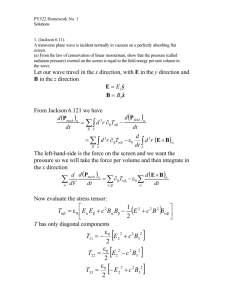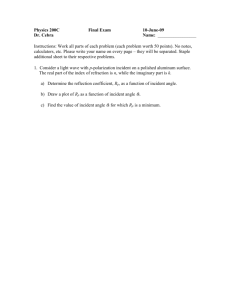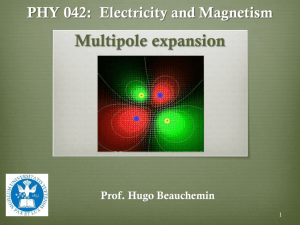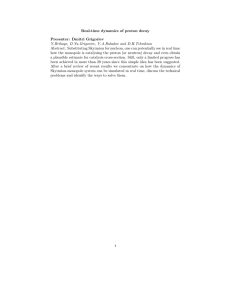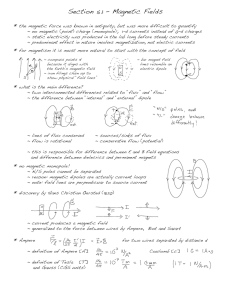Baryon Number Muncher Monopoles Justin Bond
advertisement
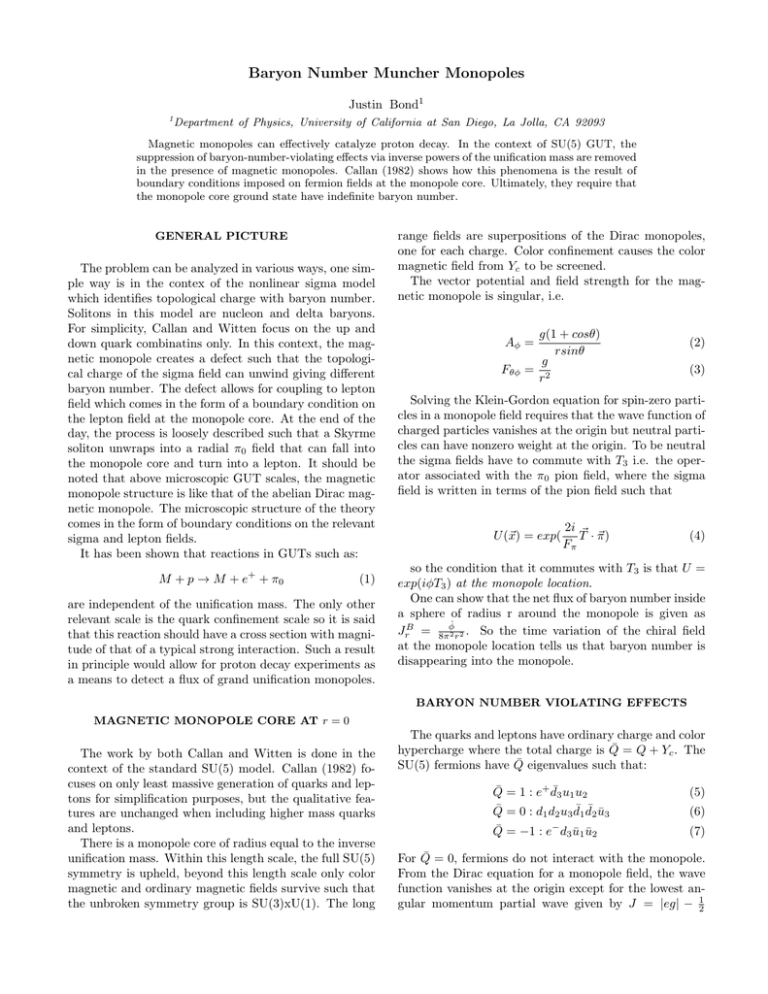
Baryon Number Muncher Monopoles Justin Bond1 1 Department of Physics, University of California at San Diego, La Jolla, CA 92093 Magnetic monopoles can effectively catalyze proton decay. In the context of SU(5) GUT, the suppression of baryon-number-violating effects via inverse powers of the unification mass are removed in the presence of magnetic monopoles. Callan (1982) shows how this phenomena is the result of boundary conditions imposed on fermion fields at the monopole core. Ultimately, they require that the monopole core ground state have indefinite baryon number. GENERAL PICTURE The problem can be analyzed in various ways, one simple way is in the contex of the nonlinear sigma model which identifies topological charge with baryon number. Solitons in this model are nucleon and delta baryons. For simplicity, Callan and Witten focus on the up and down quark combinatins only. In this context, the magnetic monopole creates a defect such that the topological charge of the sigma field can unwind giving different baryon number. The defect allows for coupling to lepton field which comes in the form of a boundary condition on the lepton field at the monopole core. At the end of the day, the process is loosely described such that a Skyrme soliton unwraps into a radial π0 field that can fall into the monopole core and turn into a lepton. It should be noted that above microscopic GUT scales, the magnetic monopole structure is like that of the abelian Dirac magnetic monopole. The microscopic structure of the theory comes in the form of boundary conditions on the relevant sigma and lepton fields. It has been shown that reactions in GUTs such as: M + p → M + e + + π0 (1) are independent of the unification mass. The only other relevant scale is the quark confinement scale so it is said that this reaction should have a cross section with magnitude of that of a typical strong interaction. Such a result in principle would allow for proton decay experiments as a means to detect a flux of grand unification monopoles. range fields are superpositions of the Dirac monopoles, one for each charge. Color confinement causes the color magnetic field from Yc to be screened. The vector potential and field strength for the magnetic monopole is singular, i.e. g(1 + cosθ) rsinθ g = 2 r Aφ = (2) Fθφ (3) Solving the Klein-Gordon equation for spin-zero particles in a monopole field requires that the wave function of charged particles vanishes at the origin but neutral particles can have nonzero weight at the origin. To be neutral the sigma fields have to commute with T3 i.e. the operator associated with the π0 pion field, where the sigma field is written in terms of the pion field such that U (~x) = exp( 2i ~ T · ~π ) Fπ (4) so the condition that it commutes with T3 is that U = exp(iφT3 ) at the monopole location. One can show that the net flux of baryon number inside a sphere of radius r around the monopole is given as JrB = 8πφ̇2 r2 . So the time variation of the chiral field at the monopole location tells us that baryon number is disappearing into the monopole. BARYON NUMBER VIOLATING EFFECTS MAGNETIC MONOPOLE CORE AT r = 0 The work by both Callan and Witten is done in the context of the standard SU(5) model. Callan (1982) focuses on only least massive generation of quarks and leptons for simplification purposes, but the qualitative features are unchanged when including higher mass quarks and leptons. There is a monopole core of radius equal to the inverse unification mass. Within this length scale, the full SU(5) symmetry is upheld, beyond this length scale only color magnetic and ordinary magnetic fields survive such that the unbroken symmetry group is SU(3)xU(1). The long The quarks and leptons have ordinary charge and color hypercharge where the total charge is Q̄ = Q + Yc . The SU(5) fermions have Q̄ eigenvalues such that: Q̄ = 1 : e+ d¯3 u1 u2 Q̄ = 0 : d1 d2 u3 d¯1 d¯2 ū3 − Q̄ = −1 : e d3 ū1 ū2 (5) (6) (7) For Q̄ = 0, fermions do not interact with the monopole. From the Dirac equation for a monopole field, the wave function vanishes at the origin except for the lowest angular momentum partial wave given by J = |eg| − 12 2 where in our case eg = Q̄g = ± 21 is the charge-monopole strength so J = 0. So J 6= 0 partial waves decouple from the SU(5) physics. Since there is no repulsive or centrifugal barrier, the entire incoming flux must pass through the origin. If the particle is charged, the electromagnetic field angular momentum is egr̂ where r̂ points from the monopole to the charge. By angular momentum conservation we can see that as the monopole charge passes through the monopole, it must change sign so that egr̂ because r̂ flips sign. This is possible because the monopole core contains fields that can cause transitions between the types of charges contained in the fermion multiplets. The fermions pair up in the following manner: (e+ , d3 ), (d¯3 , e− ), (u1 , ū2 ), (u2 , ū1 ) such that the first(second) component corresponds solely to an incoming(outgoing) wave. When fermions interact with the core, the net change in charge must be equal to that deposted onto the monopole. The net effect couples Q̄ = +1 with Q̄ = −1 fields. This also amounts to SU(5) effects coupling to low-energy fermion physics as the coupling is due to the SU(5) structure of the monopole. Since only the J = 0 degrees of freedom are relevant, we may now simplify the problem and focus only on this partial wave. The field variable then only depends on one variable, the radial distance from the core. In such a case, a bosonization method is useful to convert the fermion theory into the dual boson theory as is done for leptons in the nonlinear sigma model apprach to this problem. A pair of Weyl fields have a corresponding scalar desciption defined on 0 < r < ∞ given by: (e+ , e− ) → Φe+ (u1 , ū1 ) → Φu1 (d3 , d¯3 ) → Φ ¯ d3 (u2 , ū2 ) → Φu2 where the boundary conditions evaluated at r = 0 Φe+ = Φd¯3 (8) Φ0e+ (9) = −Φ0d¯3 Φu1 = Φu2 (10) Φ0u1 (11) = −Φ0u2 (12) The value Φi (r) √ π is the net number of i-particles con- represents tained in a sphere of radius r and thus Φ√i (0) π the net number of i-particles sitting on the monopole core. The quarks and leptons appear as solitons in the scalar theory. The form of the soliton is such that the value of Φi takes a step from one minimum to a neighboring min√ imum of Φi , where the minima are such that Φi = n π. For particles far from the monopole core, the Lagrangian is a sum of sine-Gordon lagrangians for each fermion type and the shape of the transition between minima are determined from the minimizing the energy. Minimizing the energy and making sure to satisfy the boundary conditions gives the following ground state of the system: √ (13) Φu1 = Φu2 = N π √ Φe+ = Φd¯3 = −N π (14) and since N is any integer, there are an infinite number of degenerate ground states. Physically, Nth vacuum state corresponds to having N baryons and N leptons at the monopole core, that is, they have N times the combination of (e− u1 u2 d3 ). Since these are all vacuum states with the same minimum energy, transitions between these states cost no energy. So, transitions from the N to N ±1 state cause a change in lepton and baryon number by 1. The monopole ground state will be a superposition of the N-vacuum states and thus a state of indefinite baryon and lepton number which is what allows the baryon-number-violating reactions. THE MUNCHING PROCESS We can appreciate this in the context of the nonlinear sigma model. For a given configuration of the chiral fields U (~x) = eif (r)T3 with the boundary conditions U (∞) = 1 so f (∞) = 2π, one can obtain the current baryon and lepf 0 (r) ton currents as J0B = J0Q = 8π 2 r 2 which we can integrate (0) to give B = Q = f (∞)−f , so the configuration has both 2π charge and baryon number even though the topological properties are not apparent. This is interesting because when one starts with the nonlinear sigma model, baryon number is at first identified with a topological charge. Witten and Callan explain how such a configuration can be smoothly reached from a Skyrme soliton coming from infinity, wrapping around the monopole in the form of a radial kink without changing the value of U at the monopole. So in the case where f (0) = 0 and f (∞) = 2π, this configuration corresponds to an eventual binding of a proton to the monopole. In the case where U (0) is allowed to vary in time. In such a case, one may use the sudden approximation method to the scattering process which amounts to an incoming soliton followed by an outgoing soliton and positron. The outgoing soliton actually has baryon number zero due to the Dirac string drilling. Dirac drilling comes from the Dirac string inducing the condition U (r, θ = 0, φ) = exp(iφ 21 T3 )U (r, 0, 0)exp(iφ 21 T3 ) where upon applying a singular gauge transformation, U becomes continuous. In the process just described, applying the gauge transformation forces the baryon number to zero. 3 So if U(0) is fixed in time, the process amounts to binding of a proton and if U(0) is allowed to fluctuate in time, the monopole is allowed to munch on the baryon number and spits out unwanted positrons and pions. perature decreased but it turns out that the monopole interactions would not decrease fast enough compared to other CP-violations interactions. This sets an upper limit on the density of monopoles that would be consistent with astrophysical evidence. IMPLICATIONS ON MONOPOLE DENSITIES Some interesting comments can be made regarding the effective monopole density in the Universe. Through a thermalization process, the monopoles can act to destroy any net baryon number. Any baryon excess produced CP-violating events would be subjected to random baryon number violating effects and would thus destroy baryon excess. Rates would decrease as Universal tem- [1] Curtis G. Callan Jr. Monopole catalysis of baryon decay. Nuclear Physics B, 212(3):391 – 400, 1983. [2] Curtis G. Callan Jr. and Edward Witten. Monopole catalysis of skyrmion decay. Nuclear Physics B, 239(1):161 – 176, 1984.
